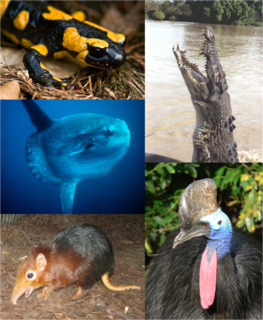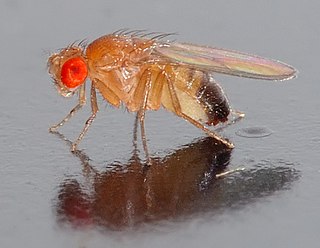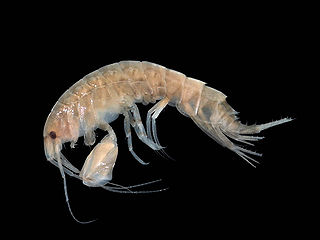
Dallas–Fort Worth sits above Cretaceous-aged strata, dates ranging from ≈145-66 Ma. These Cretaceous-aged sediments lie above the eroded Ouachita Mountains and the Fort Worth Basin, which was formed by the Ouachita Orogeny. Going from west to east in the DFW Metroplex and down towards the Gulf of Mexico, the strata gets progressively younger. The Cretaceous sediments dip very gently to the east.
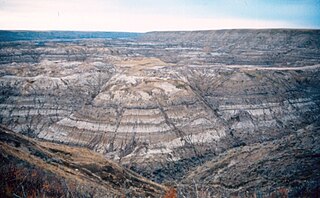
The Horseshoe Canyon Formation is a stratigraphic unit of the Western Canada Sedimentary Basin in southwestern Alberta. It takes its name from Horseshoe Canyon, an area of badlands near Drumheller.
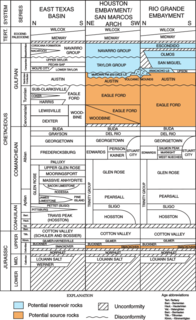
The Glen Rose Formation is a shallow marine to shoreline geological formation from the lower Cretaceous period exposed over a large area from South Central to North Central Texas. The formation is most widely known for the dinosaur footprints and trackways found in the Dinosaur Valley State Park near the town of Glen Rose, Texas, southwest of Fort Worth and at other localities in Central Texas.

Polyptychodon is a genus of pliosaurid found Middle-Late Cretaceous marine deposits in southern England. It has been considered a nomen dubium in a 2016 review.
The Niobrara Formation, also called the Niobrara Chalk, is a geologic formation in North America that was deposited between 87 and 82 million years ago during the Coniacian, Santonian, and Campanian stages of the Late Cretaceous. It is composed of two structural units, the Smoky Hill Chalk Member overlying the Fort Hays Limestone Member. The chalk formed from the accumulation of coccoliths from microorganisms living in what was once the Western Interior Seaway, an inland sea that divided the continent of North America during much of the Cretaceous. It underlies much of the Great Plains of the US and Canada. Evidence of vertebrate life is common throughout the formation and includes specimens of plesiosaurs, mosasaurs, and pterosaurs as well as several primitive aquatic birds. The type locality for the Niobrara Chalk is Knox County in northeastern Nebraska.

The Kaskapau Formation is a geological formation in North America whose strata date back to the Late Cretaceous.

The Woodbine Group is a geological formation in east Texas whose strata date back to the Early to Middle Cenomanian age of the Late Cretaceous. It is the producing formation of the giant East Texas Oil Field from which over 5.42 billion barrels of oil have been produced. The Woodbine overlies the Maness Shale, Buda Limestone, or older rocks, and underlies the Eagle Ford Group or Austin Chalk. In outcrop the Woodbine Group has been subdivided into the Lewisville Sandstone, Dexter Sandstone, and/or Pepper Shale formations. Thin-bedded sands of the Woodbine and Eagle Ford are collectively referred to as the "Eaglebine" oil and gas play in the southwestern portion of the East Texas region.

Hauffiosaurus is an extinct genus of Early Jurassic pliosaurid plesiosaur known from Holzmaden of Germany and from Yorkshire of the United Kingdom. It was first named by Frank Robin O’Keefe in 2001 and the type species is Hauffiosaurus zanoni. In 2011, two additional species were assigned to this genus: H. longirostris and H. tomistomimus.
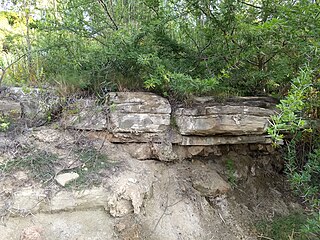
The Sundays River Formation is a geological formation found in the Eastern and Western Cape provinces in South Africa. It is the second youngest of the four formations found within the Uitenhage Group of the Algoa Basin, its type locality, and the only location where outcrops have been located. The Sundays River has been measured at a maximum thickness of 2,000 metres (6,600 ft).
The Lake Waco Formation is a geologic formation within the Eagle Ford Group deposited during the Middle Cenomanian to the Early Turonian of the Late Cretaceous in central Texas. The formation was named for outcrops near Lake Waco, south of the city of Waco, Texas by W. S. Adkins and F. E. Lozo in 1951. The Lake Waco Formation is primarily composed of shale, with minor amounts of limestone and volcanic ash beds (bentonites). It is subdivided into three members: Bluebonnet Member, Cloice Member, and the Bouldin Member. The Bluebonnet Member is 10 to 20 ft thick, and is made up of broken pieces (prisms) of inoceramid clams and planktonic foraminifera. The Cloice Member is 35 ft thick at its type section on the Cloice Branch of the South Bosque River, whereas the Bouldin Member was named for outcrops on Bouldin Creek south of downtown Austin, where it is roughly 9 ft thick. They are both made up of shales rich in organic matter with thin limestones and volcanic ash beds.
Aetodactylus is a genus of ornithocheirid pterodactyloid pterosaur. It is known from a lower jaw discovered in Upper Cretaceous rocks of northeastern Texas, United States.

Albertonectes is an extinct genus of elasmosaurid plesiosaur known from the Late Cretaceous Bearpaw Formation of Alberta, Canada. It contains a single species, Albertonectes vanderveldei. Albertonectes is the longest elasmosaur, and more generally plesiosaur, known to date both in neck and total body length.

Cimoliopterus is a genus of pterodactyloid pterosaur from the Cretaceous of England, United Kingdom and Texas, United States.
The Boquillas Formation is a geologic formation deposited during the Late Cretaceous in modern-day West Texas. It is typically composed of alternating marls and limestones with thin volcanic ash beds (bentonites). It was named for outcrops near the former Boquillas post office in Big Bend National Park. The term Boquillas Formation has been used for rocks that outcrop from Del Rio, Texas to as far west as Doña Ana County, New Mexico.
The Arcadia Park Shale is a geologic formation within the Eagle Ford Group that outcrops in the northern portion of East Texas. It was deposited during the Middle to Late Turonian of the Late Cretaceous. It was originally described by W. L. Moreman from outcrops near the former Arcadia Park railway station west of downtown Dallas, where it is 100 ft thick. In the type area there is an unconformity between the Arcadia Park and the underlying Britton Formation. The base of the Arcadia Park is a thin limestone termed the Kamp Ranch Limestone. The Kamp Ranch Limestone is made up of broken pieces (prisms) of Inoceramus clams, and also contains shark's teeth. The remainder of the Arcadia Park in the Dallas area is shale with concretions. Sandstones are found within the Arcadia Park north of Dallas. The sandstones have been termed the Bells Sandstone Member for outcrops in Grayson County, and the Sub-Clarksville Sandstone in the subsurface. The shale overlying the Bells Sandstone has been named the Maribel Shale

The Eagle Ford Group is a sedimentary rock formation deposited during the Cenomanian and Turonian ages of the Late Cretaceous over much of the modern-day state of Texas. The Eagle Ford is predominantly composed of organic matter-rich fossiliferous marine shales and marls with interbedded thin limestones. It derives its name from outcrops on the banks of the West Fork of the Trinity River near the old community of Eagle Ford, which is now a neighborhood within the city of Dallas. The Eagle Ford outcrop belt trends from the Oklahoma/Texas border southward to San Antonio, westward to the Rio Grande, Big Bend National Park, and the Quitman Mountains of West Texas. It also occurs in the subsurface of East Texas and South Texas, where it is the source rock for oil found in the Woodbine, Austin Chalk, and the Buda Limestone, and is produced unconventionally in South Texas and the "Eaglebine" play of East Texas. The Eagle Ford was one of the most actively drilled targets for unconventional oil and gas in the United States in 2010, but its output had dropped sharply by 2015. By the summer of 2016, Eagle Ford spending had dropped by two thirds from $30 billion in 2014 to $10 billion, according to an analysis from the research firm, Wood Mackenzie. This strike has been the hardest hit of any oil fields in the world. The spending is, however, expected to increase to $11.6 billion in 2017. A full recovery is not expected any time soon.
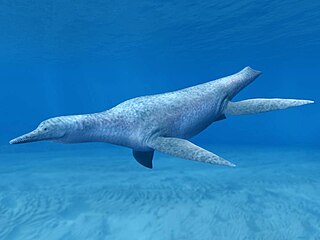
Mauriciosaurus is a genus of polycotylid plesiosaur from the Late Cretaceous of Mexico. It contains a single species, M. fernandezi, described in 2017 by Eberhard Frey and colleagues from a single well-preserved juvenile specimen about 1.9 metres long. Morphologically, it is overall most similar to the polycotyline polycotylids Trinacromerum and Dolichorhynchops. However, several features separate Mauriciosaurus from all other polycotylids, warranting the naming of a new genus. These include the sophisticated pattern of ridges on the bottom of the parasphenoid bone on its palate; the narrow openings in the palate bordered by the pterygoid bones; the lack of perforations in the surface of the coracoid; and the highly unusual arrangement of gastralia, or belly ribs, which is only otherwise seen in the non-polycotylid Cryptoclidus.

Leyvachelys is an extinct genus of turtles in the family Sandownidae from the Early Cretaceous of the present-day Altiplano Cundiboyacense, Eastern Ranges, Colombian Andes. The genus is known only from its type species, Leyvachelys cipadi, described in 2015 by Colombian paleontologist Edwin Cadena. Fossils of Leyvachelys have been found in the fossiliferous Paja Formation, close to Villa de Leyva, Boyacá, after which the genus is named. The holotype specimen is the oldest and most complete sandownid turtle found to date.
